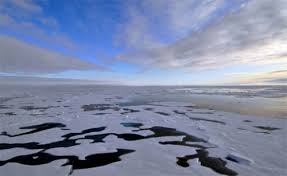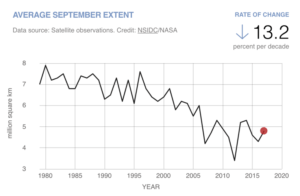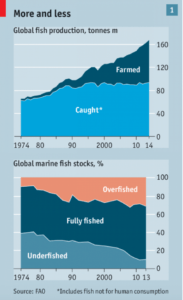Plenty of Fish – How to Sustainably Harvest New Fish

As the arctic ice shrinks, sunlight will enter the arctic ocean which was previously dark. Fish that hunt by sight are expected to enter this ecosystem in record numbers and thrive on all the pristine food, which the arctic ocean is abundant. Although in the short term, large seafood companies, like Maruha Nichiro (MN) will benefit from this influx of fish, this benefit is likely to be short-lived given the industry’s tendency to overfish and deplete fish species in the Arctic. A critical challenge for Maruha Nichiro will be to avoid mistakes of the past and learn how to harvest this new resource sustainably.
Intergovernmental panel on climate change is 95% certain that human activities are the main cause for the warming of our planet [1]. The rapid change in climate is creating several losers – coastal communities, arctic mammals, farmers from the changing weather patterns – and will ultimately reshape human life the way we see it today. But when some loose, others win, in this case, disproportionately. As the arctic ice shrinks, sunlight will enter the arctic ocean which was previously dark. Fish that hunt by sight are expected to enter this ecosystem in record numbers and thrive on all the pristine food, which the arctic ocean is abundant [2].
So, who will benefit from this change? Salmon, Atlantic Cod, Mackerel and therefore one of the largest seafood companies by revenue – Maruha Nichiro (MN). However, this benefit may be short-lived given the industry’s tendency to overfish and deplete fish species in the Arctic. A critical challenge for Maruha Nichiro will be to avoid mistakes of the past and learn how to harvest this new resource sustainably.
Figure 1: Decline in Arctic Ice Coverage Source: NSIDC/NASA, “Satellite Observations“
Source: NSIDC/NASA, “Satellite Observations“
Worldwide fisherman in many coastal areas rely on fishing as a source of income and also for sustenance. The industry is fragmented based on numbers, but concentrated in terms of value. While 16% of the catch goes to 13 companies globally, these companies control 40% of the valuable and bigger variety of fish [3]. The industry is plagued with illegal fishing where rouge vessels catch endangered species of fish or catch beyond the allocated quota by fishing in international waters that are not carefully patrolled or trespassing on other nation’s waters. Such practices lead to overfishing and in the past, has depleted fish stock in certain areas. Fish stocks are seldom replenished; according to UN, 70% of the world’s fish species are either fully exploited or depleted [4]. Now, with the arctic ice melting, global fish stocks for certain species will regenerate creating an economic opportunity for the fishing industry. This creates a challenge for the management of this company on how to best harvest this resource as a result of climate change.
Figure 2: Increasing Percentage of Overfished Global Fish Stock Source: The Economist, “Getting Serious About Overfishing“
Source: The Economist, “Getting Serious About Overfishing“
Maruha Nichiro, for the first time in history, joined by seven other companies, agreed on a commitment (seaBOS) to improve transparency in supply chain. The objective is to reduce illegal fishing, reduce antibiotic use in aquaculture, and reduce greenhouse gas emissions [5]. A major driver for this cooperation is economic benefit for all companies. A recent study found that proper management of fish stock can lead to $53 billion in profit compared to the current trend [6]. This seaBOS commitment is in the right direction, however unlikely to be enough to reverse perverse incentives to overfish.
There are several important questions for Maruha Nichiro management to consider. How will the aforementioned pact hold when fish stocks become accessible in the arctic? How do you balance the organization’s view on climate change versus taking benefit from the phenomenon? How do you convince competitors to cooperate and not destroy a fragile ecosystem that has already been destroyed once by melting ice?
My recommendation to management would be to take a series of steps that make their stance on this crisis clear and lead the industry by establishing a balanced approach to the issue at hand.
- Expand the seaBOS pact to include the arctic circle and quota allocation for fish stock in that region.
- Invest in research by supporting organizations that are involved in monitoring fish stock regeneration and partner with research institutes and universities to reduce or eliminate harm to the marine ecosystem in the arctic.
- Increase dependence on aquaculture by changing consumer perception by advertising and highlighting the benefits of farmed fish to the environment. Management will have to ensure that the investments they make in aquaculture don’t further increase greenhouse emissions for fish feed and instead use natural feeds.
- Design a robust system to monitor each member’s performance and strengthen current standards to reduce illegal fishing by also including companies from other major fishing countries such as China and Russia.
Ultimately, it is unrealistic to expect seafood companies to not harvest this new-found resource but doing so in a sustainable manner can prevent making the same mistake twice in the arctic. It is unclear how and whether management can bring China to the table which has a massive population that needs to be fed. Another concern is how investors will react to the company’s decision to optimize revenue for their long-term as oppose to maximize profits immediately.
(Words 780/800)
[1] IPCC, 2014: Climate Change 2014: Synthesis Report. IPCC, Geneva, Switzerland (2014). http://www.ipcc.ch/pdf/assessment-report/ar5/syr/SYR_AR5_FINAL_full_wcover.pdf
[2] James Owen, “How Arctic Fish Might Benefit From Shrinking Ice,” National Geographic (December 17, 2015) https://news.nationalgeographic.com/2015/12/151217-arctic-ice-fish-predators-prey-animals-science/
[3] “Nine of World’s Biggest Fishing Firms Sign Up to Protect Oceans,” The Guardian, June 9, 2017. https://www.theguardian.com/environment/2017/jun/09/nine-of-worlds-biggest-fishing-firms-sign-up-to-protect-oceans
[4] Nick Nuttal, “Overfishing: A Threat to Marine Biodiversity,” United Nations Environment Programme. http://www.un.org/events/tenstories/06/story.asp?storyID=800
[5] Henrik Österblom, “International seafood business commits to stronger sustainability efforts,” Stockholm Resilience Centre. http://www.stockholmresilience.org/research/research-news/2016-12-14-international-seafood-business-commits-to-stronger-sustainability-efforts.html
[6] Christopher Costello, “Global fishery prospects under contrasting management regimes,” Proceedings of the National Academy of Sciences of the Unites States of America, October 14, 2015. http://www.pnas.org/content/113/18/5125.full



Maruha Nichiro should pressure other companies to join the seaBOS agreement by allowing companies who join the agreement within a certain time frame have a voice in any modifications to the seaBOS agreement. Maruha Nichiro should also have the explicit goal of sending the seaBOS agreement from the international body of fishing companies to the politicians in their respective countries as the preferred adoption as an international political agreement.
As the country with the highest volume of marine fishing, China wants to be at the table anytime the the “Arctic Five” (US, Canada, Denmark, Norway, Russia) meet to discuss the future of the Arctic waters. In order to have access to the arctic waters for fishing without a public relations backlash, China has an incentive to negotiate with other international players to reach an international fisheries agreement. These talks are currently on-going and while the talks are far from final, there is a concerted effort to reach an international agreement and thus any company in the business of fishing has an incentive to also have their voice heard before finalization of the political agreement.
Thanks for writing this article, Emily! The fishing industry often flies under the radar yet there are major economic, geopolitical, and ethical implications that go into fishing regulation. I agree that seaBOS is a good first step to addressing the overfishing temptation being opened up in the arctic for large fishing operations but it does not disincentivize rogue, independent fishermen from continuing to over-harvest. I like your third recommendation of building up sustainable aquaculture, particularly in high demand areas like China. Aquaculture practices have improved greatly in recent years and now produce fish that are safer to eat while reducing pollution coming from these operations, and building up additional fish farms could result in an additional revenue stream for Maruha Nichiro. I would also recommend that the large fishing companies work with organizations like Seafood Watch, FishWise, and Friends of the Ocean to influence customer demand for certain species at restaurants and retail locations as decreased demand for at-risk fish populations is perhaps the best way to combat illegal overfishing.
Hi Emily – thanks a lot for writing this article! I have never thought of the fishing industry under this light and on how much the climate change could influence their activity. I really like your recommendations and i wanted to ask you if you see an active role played also by a more environmental friendly mentality and shift in consumer habits. With an increasing number in vegetarian, vegan and other non-fish diets, do you think the overall fishing demand will continue to rise or will the supply exceed by far the demand? How do you think big fishing companies will react to this shift in customer demand?
As a daughter to a father who loves fishing as a hobby I remember watching him while he used to catch a small fish and throws it back to the water saying: “he deserves to grow” 🙂 Unfortunately fishermen who are making a living from this industry will not think the same. they want to increase their profits on the short term as there are “Plenty of fish in the sea”. I love your recommendations but have a more pessimistic view that without a real pressure from society or a real shift in consumer eating habits as Giovanni mentioned the pursue to overfish will remain.
I wonder how many species that were safe until now will be effected not only by those companies but by the actual change of water temperature that causes their environment to be much warmer then it was couple of years ago, and how the disappearance of those would potentially effect the entire food chain in the ocean.
Hi Emily – thanks a lot for writing this article!
I think this is a very interesting topic, how to ensure sustainability of our food supply. This is a topic that need to involve countries from all over the world to work together.
Personally, I think there is a way to make this sustainable. But it is not easy.
1. Promote alternative food other than fish, e.g., generic transformed grains or rice that can grow faster and produce more. This has been promoted in China for many years and the impact is big.
2. Set up regulations that regulate the fishing activities in the water. For example, divide the fishing area into multiple field, and only fish in each field every couple of year or season.
I am sure there will be more ways to do this. The world population has be growing exponentially in the past decade, and many countries are able to not only grow its population, but also its living standard. But again, to make this happen on a world level, we need the corporation of countries in the world and work together.
Emily, you touched on a very important subject. I would like to add one more consideration to this challenge. We, customers, have a lot to say in this circumstances. If the general population is educated and aware that over-fishing in Arctic Region can cause significant long-term issues for future generations, people might just stop buying fish that was caught in Arctic. I know many people who prefer farmed fish that was grown in controlled environments where customers know what they are getting. These will be huge incentives for management of fishing companies. If they optimize costs, improve technology and reduce the use of antibiotics – farmed fish can reduce the need for expensive fishing in Arctic.